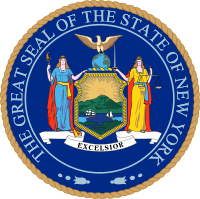New York state election, 1865
The 1865 New York state election was held on November 7, 1865, to elect the Secretary of State, the State Comptroller, the Attorney General, the State Treasurer, the State Engineer, two Judges of the New York Court of Appeals, a Canal Commissioners, an Inspector of State Prisons and the Clerk of the Court of Appeals, as well as all members of the New York State Assembly and the New York State Senate.
History
The Democratic state convention met on September 6 and 7 at Albany, New York. C. H. Winfield was Temporary Chairman until the choice of James M. Humphrey as President.;[1][2]
The Republican state convention met on September 20 at Syracuse, New York. Charles J. Folger was Temporary Chairman until the choice of Chauncey M. Depew as Permanent Chairman. Ward Hunt and John K. Porter were nominated for the Court of Appeals by acclamation. Francis Barlow was nominated for Secretary of State on the first ballot (vote: Barlow 191, Charles H. Van Wyck 172, Daniel E. Sickles 3, Chauncey M. Depew [incumbent] 1). Thomas Hillhouse was nominated for Comptroller on the first ballot (vote: Hillhouse 253, James A. Bell 82, Tracy Beadle 25). John Howland was nominated for Treasurer on the first ballot (vote: Howland 208, George W. Schuyler [incumbent] 146). John H. Martindale was nominated for Attorney General by acclamation. J. Platt Goodsell was nominated for State Engineer on the second ballot (first ballot: Goodsell 123, Charles K. Graham 123, William B. Taylor [incumbent] 72, Charles W. Mentz 26, Daniel C. Jeune 21; second ballot: Goodsell 200, Graham 153, Taylor 7). Robert C. Dorn was nominated for Canal Commissioner on the first ballot (vote: Dorn 186, Alexander Barkley 160). Henry A. Barnum was nominated for Prison Inspector during the first ballot. Patrick H. Jones was nominated for Clerk of the Court of Appeals by acclamation.[3]
Results
The whole Republican ticket was elected.
The incumbent Porter was re-elected. The incumbent Robinson was defeated.
27 Republicans and 5 Democrats were elected to a two-year term (1866–67) in the New York State Senate.
91 Republicans and 37 Democrats were elected for the session of 1866 to the New York State Assembly.
| Office | Republican ticket | Democratic ticket | ||
|---|---|---|---|---|
| Secretary of State | Francis C. Barlow | 301,055 | Henry W. Slocum | 273,198 |
| Comptroller | Thomas Hillhouse | 302,428 | Lucius Robinson | 271,852 |
| Attorney General | John H. Martindale | 302,437 | John Van Buren | 271,264 |
| Treasurer | Joseph Howland | 302,245 | Marsena R. Patrick | 272,039 |
| State Engineer | J. Platt Goodsell | 302,001 | Sylvanus H. Sweet | 272,338 |
| Judge of the Court of Appeals (full term) | Ward Hunt | John W. Brown | ||
| Judge of the Court of Appeals (short term)[4] | John K. Porter | Martin Grover | ||
| Canal Commissioner | Robert C. Dorn | 303,556 | Cornelius W. Armstrong | 270,700 |
| Inspector of State Prisons | Henry A. Barnum | 301,925 | Andrew J. McNett | 271,957 |
| Clerk of the Court of Appeals | Patrick H. Jones | Edwin O. Perrin | ||
Sources
- Result in The Tribune Almanac compiled by Horace Greeley of the New York Tribune (Greeley still identifies the Republicans as "Unionists", but by the time of this election the Civil War was over and the parties re-aligned. For example, the Democratic ticket had Union generals Slocum and Patrick, War Democrat Van Buren, and pre-war Republican Robinson.)
- The tickets: THE ELECTION TO-DAY in NYT on November 7, 1865 (giving "Republican" and "Democratic" tickets)
Notes
- ↑ STATE POLITICS.; The New-York Democratic Convention in NYT on September 7, 1865
- ↑ GENERAL NEWS in NYT on September 8, 1865
- ↑ UNION STATE CONVENTION.; ...The Democratic Candidates Entirely Ignored in NYT on September 21, 1865 (The headline says "Union", but the text says "Republican". Although the Union was still very much invoked, and most of the ticket were Union generals (Barlow, Hillhouse, Martindale, Howland, Barnum and Jones) this was a real Republican party meeting.)
- ↑ To fill the vacancy caused by the resignation of Henry R. Selden, a judge was elected to a six-year term.
